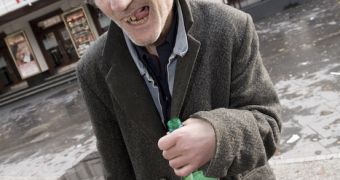One could blame the Siberian cold and long winters but, in many countries, Russians - both men and women - are famous for their heavy consumption of vodka. And this is also applied to Russian communities outside Russia, such as the Lipovans.
But when a team led by David Leon at the London School of Hygiene and Tropical Medicine, UK, investigated the phenomenon in western Russia, they got a shocking result: 43% of deaths in working-age Russian men were caused by drinking alcohol not meant for human consumption, like cologne and cleaning agents.
This study explains why Russian men are ranked as having the lowest life expectancy among industrialized nations, at just 59 years old.
The team interviewed the housemates and family members of 1750 deceased men, aged 25-54, but also 1750 similarly aged men in the industrial city of Izhevsk. The questionnaires focused on how much and what types of alcohol both groups drank.
Individuals were classified as presenting a "hazardous pattern of drinking" if they had a hangover more than twice a week, if engaged in a bout of extreme binge drinking (zapoї) inducing drunkenness lasting at least two days or if they ingested non-beverage alcohols, like eau de cologne, at least once a year. "Many Russian men who fall on hard times start drinking non-beverage alcohols because they are cheaper and have a high alcohol content," said Leon.
A 100 ml bottle of 190-proof eau de cologne can be bought with 15 rubles (29 pence or $0.60) while the smallest volume bottle of 80-proof vodka, of 0.75 liters, costs 70 rubles (?1.40 or $2.70). "The consumption of non-beverage alcohol products is widespread. Even 8% of the men in the control group drank them," signaled the researchers.
The analysis of the gathered data revealed that Russian men who consume non-beverage alcohol present a five-times higher risk of alcohol-related death (like liver cirrhosis and alcohol poisoning) than those who do not consume these products. Those consuming only non-beverage alcohols presented up to a 20-times greater risk of death. Still, these numbers are underestimates, as the approach did not include men who lived alone or on the streets. "Non-beverage alcohols are particularly dangerous because of their high-alcohol concentration, which can strip the airways that deliver oxygen to the lungs," said Leon.
"Economic hardship following the dissolution of the Soviet Union has contributed to problem drinking in Russia. For a lot of people in Russia the bottom just fell out. And they don't have a social safety net," said David Cutler at Harvard University in Cambridge, Massachusetts, US, who has studied the impact of alcoholism in the country. In 2005, official data from Russia linked alcohol to 72% of murders and 42% of suicides.

 14 DAY TRIAL //
14 DAY TRIAL //